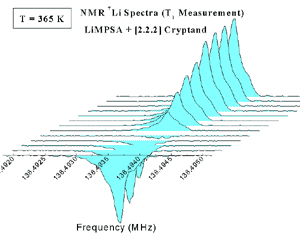Push-Button Analysis Aids continued...
Recent work with LiMPSA + Cryptand
The majority of our work to date has been directed at better understanding the amorphous electrolyte Lithium N-(3methoxypropyl) trifluoromethanesulfonamide (LiMPSA) + [2.2.2] cryptand. The LiMPDA salt acts as a cation donor while cryptand servers as a polymer host to increase the cations' mobility, and thus the electrolyte's conductivity. A subject of interest is the interactions of the chemical with the cations, and their effectiveness in "liberating" them. In collaboration with a Northwestern chemistry research group, we have brought NMR to bear on this situation. Since typical cations move through a changing magnetic environment produced by the motion of other nuclear and atomic magnetic moments in their vicinity, NMR can probe the motion itself by sensing those variations.

Our approach was to probe the motion of the conductive species (lithium) by performing NMR on its nuclear magnetic moment. Thus far we have performed relaxation measurements on the lithium cations in the material, and extracted preliminary motion parameters from that data. We have made extensive measurements of the spin-spin and spin lattice relaxation times over a wide temperature range (-90o C to 100 o C) of lithium nuclear spins within an amorphous electrolyte. Modeling the lithium cations' motion as a "hopping" behavior, we have extracted average activation energies and attempt frequencies from our data, and compared with calculations for similar parameters due to other components of the material.
Probing lithium's mobility
Our first measurements of this type were the NMR relaxation times. Since local field variations provide the coupling behind this relaxation, the T1 rate probes the time-scale and field-scale for the variations in field seen by the lithium cations. Viewing the lithium's motion as "hopping" over various electrostatic barriers, we can extract from the T1 data the average energy barrier felt by the lithium cations. Comparing this energy scale to that found in other parts of the liquid, such as the cryptand molecular "cages" that ideally surround and mobilize cations, lends direct insight into whether the lithium cations are indeed spending the most time in the company of the cryptand as hoped. Energy scales can be independently calculated for the other "members" of the substance and compared with the barriers we have experimentally determined. Further information from the local magnetic environment can be gleaned from spin-spin relaxation time, or T2, measurements. T2 is a probe of the spatial variation of the local magnetic field component along the applied field. Thus, it also provides information on the mobility of the lithium cations.

Return to Application Articles